It’s an amazing thing that for the sake of some fractions of a second of reverberation time, and some other acoustic niceties, and for the sake of acoustic properties that can only be described with vague adjectives such as “warm”, it is proposed that several hundred million pounds be spent on a completely new concert hall in London, to improve on the existing Royal Festival Hall (built in 1951, extensively renovated in 1964 and 2007) and the Barbican (built in 1982, extensively renovated in 1994 and 2001).
This is what Simon Rattle, future music director of the London Symphony Orchestra, is saying, and he has got George Osborne and Boris Johnson to support him. Rattle says that London needs the best possible concert hall, where you can “experience the sound of a great orchestra with brilliance, immediacy, depth, richness and warmth”, to attract the best possible musicians, which means shifting very many tons of building materials to fine-tune the vibrations of air. And if there is one thing that almost everyone agrees on in this contentious project (why spend so much in straitened times? Wouldn’t it be better to back performers directly rather than their carapace? Should so much be spent in culturally well-endowed London?), it is that the acoustics of the city’s existing large auditoriums definitely don’t work well enough.
Which means that if this project is to go ahead, it definitely, absolutely, without a shadow of doubt, must get its acoustics right. And although computer modelling techniques have enhanced the design of acoustics hugely since the days of the Festival Hall and the Barbican, it is still what one architect with experience of such things calls a “dark science”. Frank Gehry, who in Los Angeles and Miami has designed some of the most successful recent spaces for music, has said that if you got the world’s two best acousticians together, you can be sure they will say the opposite of each other.
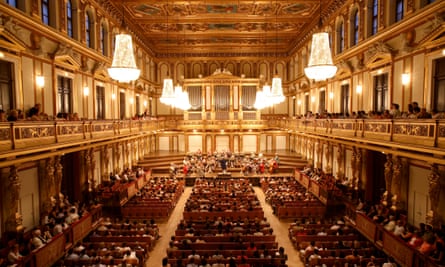
There are two main types of concert hall – the long, oblong shape known as the “shoebox”, and all the others. Usually, shoeboxes, of which the greatest example is the 19th-century Musikverein in Vienna, work, and the other sort don’t. It is largely to do with the angles at which echoes bounce of the walls and reach different parts of the audience. In the mid-20th century, architects felt emboldened to experiment with shapes of auditoriums, and introduce curves and swoops that looked as if they were in some way musical, but in practice were not. A reaction set in, where acousticians ruled and architecture was relegated. It gave us the Birmingham Symphony Hall, created under Rattle’s leadership a quarter of a century ago, which sounds good but looks horrible.
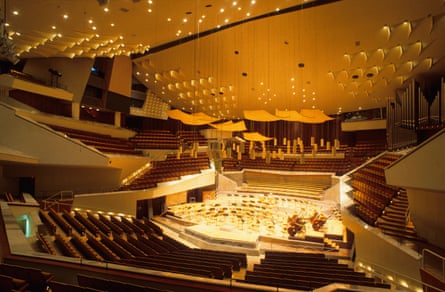
The grand exception is Rattle’s current home, the Philharmonie in Berlin, built to the designs of Hans Scharoun in 1963. It swoops and billows. The audience is arranged around a roughly central stage in tiers and terraces that the architect called “vineyards”. Its striking shapes might now get it called “iconic”, but everything is to a purpose. Somehow, despite lacking the computer modelling of the present, Scharoun achieved an acoustic that is considered one of the best in Europe.

If the new London concert hall is as good as the Philharmonie, acoustically and architecturally, all gripes about expense will be forgotten, but it’s a big if. Alternatively, it could follow the model of Rem Koolhaas’s Casa da Música in Porto, which chooses to play it safe with a shoebox auditorium, such that it can be daring and inventive in every other way. Or it could follow Gehry’s Walt Disney Concert Hall in Los Angeles, where the architect’s characteristically extravagant forms camouflage a fundamentally rectangular and acoustically successful space. Or it could turn down the histrionics knob and be a building that does, very beautifully, what it is supposed to do.
This is not just a question of sound. At its very best a visit to a musical performance is a multi-sensory, spatial, three-dimensional experience. It is influenced by the properties of surfaces, materials and light, interactions between performers, audience and each other, the way you move through foyers and up stairs and lifts. It extends to the streets around: the experience of a night of music includes getting there and leaving and eating and drinking in the neighbourhood.

It is not just about quality, about specifying stone or timber of comforting expense, but making spaces that heighten awareness, take you out of the everyday, and let you know that you are in the realm of something special. Nor is it about pure spectacle or making icons, noisy forms that out shout the music. Some effects of light or finish might look unimportant to the casual observer, but still be crucial to the power of the space. The built and visible should complement and enhance, not mimic or compete with the auditory. The strength of the shoebox, for example, is that its rectangularity differs from but supports the fundamental curviness of music – of sound waves and most musical instruments.
As in music, the subtle, the un-obvious, the complex and the contradictory are important. The architecture should not always be about the biggest and brightest notes, the catchiest tunes, the most tappable rhythms, such things being rather enhanced by passages of uncertainty and quiet. If the government can find large sums to sponsor musical nuance, then there should be nuance in the architecture too.
The feasibility study, put forward by the backers of the new concert hall, doesn’t quite say all of this. It rightly stresses acoustics and the best possible facilities for rehearsal and performance. It talks about designing a concert hall for the digital age, and one that is accessible, “welcoming”, “porous”, “reflecting diversity”. These are good aims, though the ways in which architecture might respond to them are indirect. The hall’s backers should be wary of designs that do so clumsily or symbolically.
More chillingly, the study talks about being a “landmark” or “beacon” in order to attract private funding. What’s wrong with this? you might ask. Nothing, in being attractive and distinctive. But the suggestion seems to be that they need to sex up the concert hall in order to lure the big sponsors essential to the success of the project. Which puts us in the realm of icons, of big, flashy gestures that endanger the acoustic and spatial experiences that would really make the hall succeed. Are major benefactors really so dumb that they won’t back a music venue simply on the basis that it does its job better than any other? Do Rattle and his cohort lack the confidence to argue for such a thing?
One project to be learned from is the Paris Philharmonie, which opened a year ago. Its design – although he claimed it was “sabotaged” – was by the eminent architect Jean Nouvel. Its birth was accompanied by budget crises and rows between its makers. Its auditorium is acoustically successful and architecturally interesting, in a Vegas sort of way. Everything else – its foyers, exterior, the spaces around it, the ways you reached across territory next to the multi-lane Boulevard Périphérique – is ghastly. The London hall, if it is going to happen, has to do better.

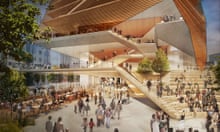

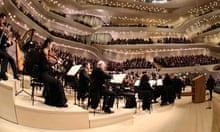
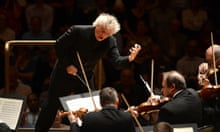



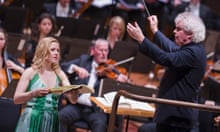
Comments (…)
Sign in or create your Guardian account to join the discussion